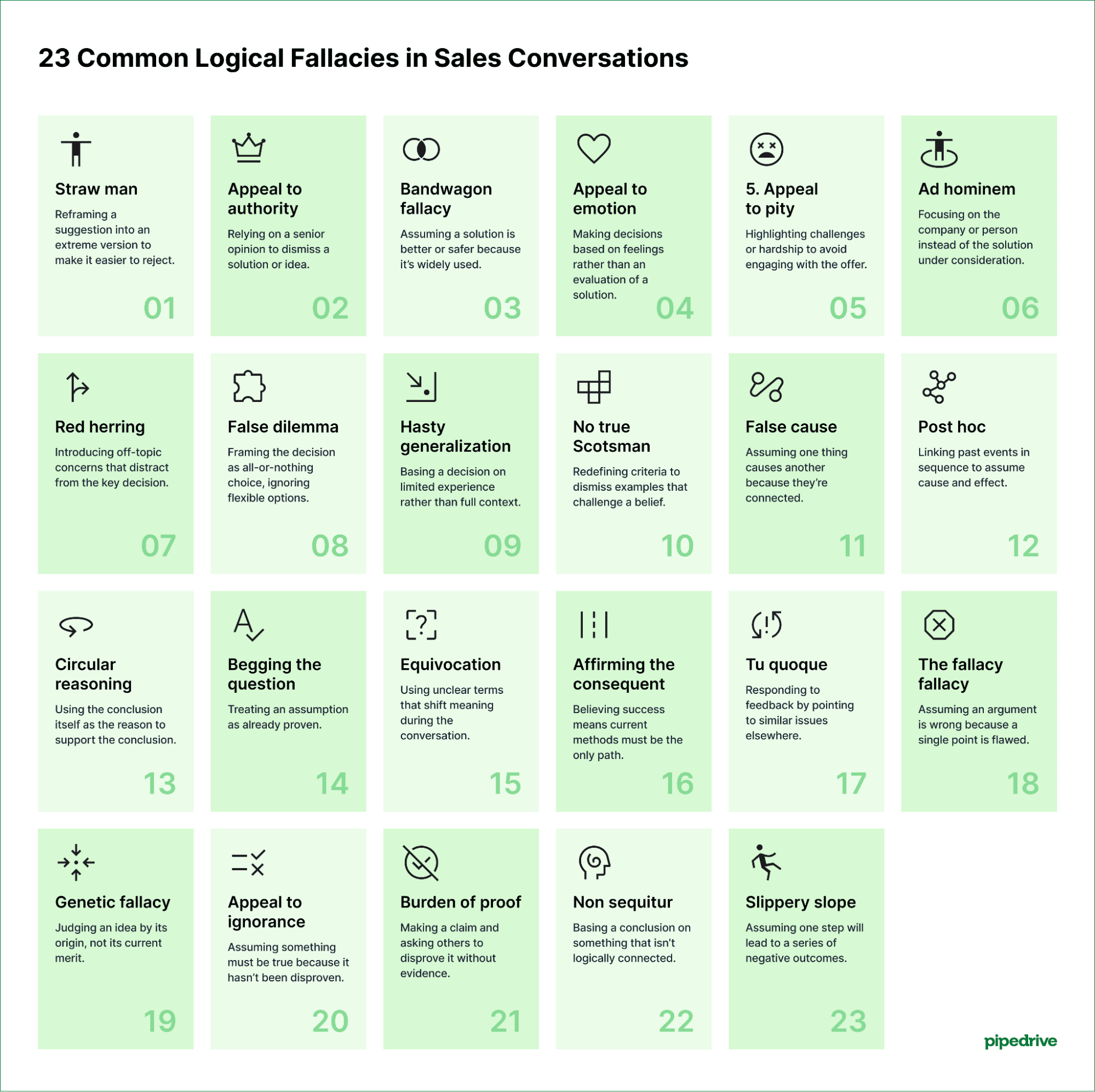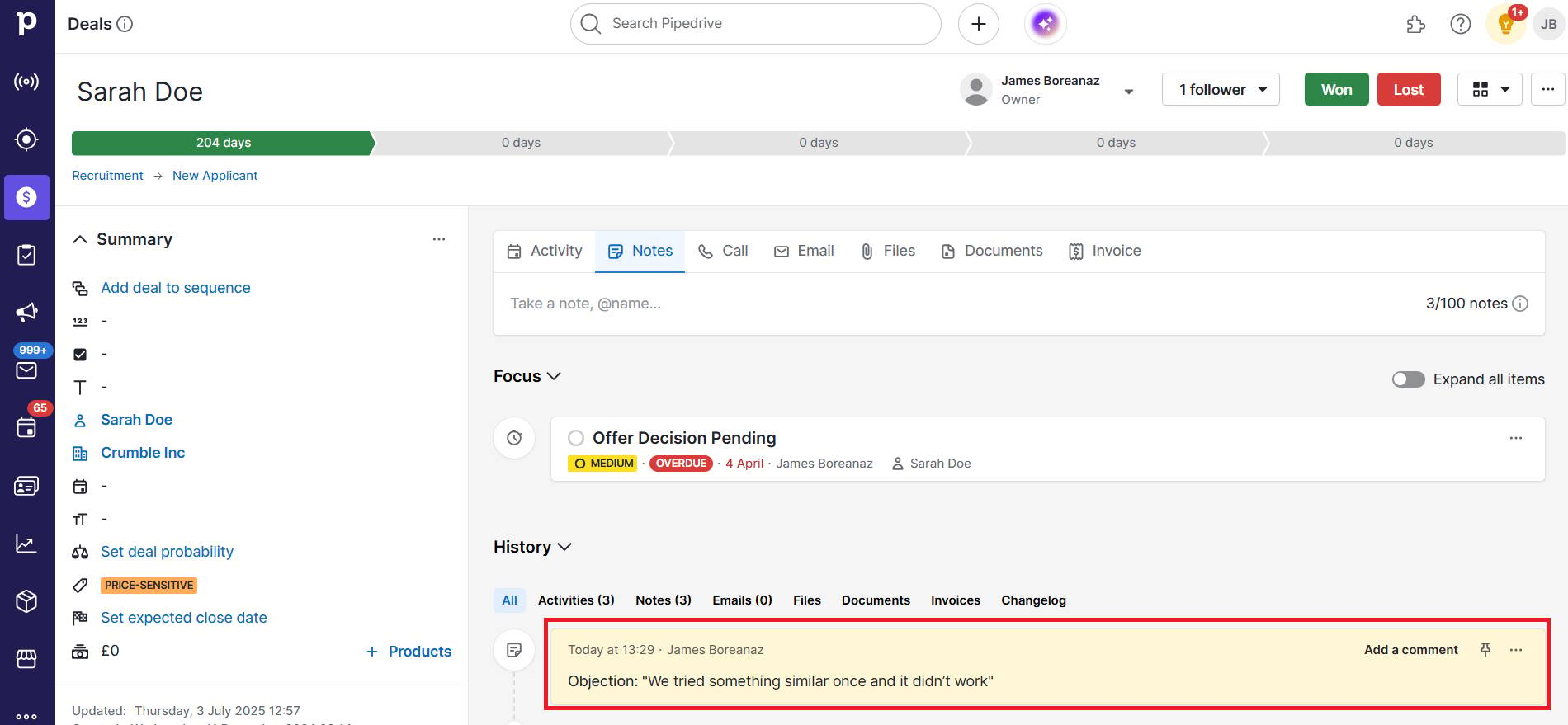Logical fallacies can quietly derail sales conversations with flawed reasoning that feels persuasive but lacks substance. When left unchecked, logical fallacies can lead to stalled deals and missed opportunities to address real objections.
In this article, you’ll learn how to spot common logical fallacies in sales conversations and respond in ways that keep deals moving forward.
What are logical fallacies in sales?
Logical fallacies are arguments rooted in flawed logic, hidden assumptions or an absence of evidence. In sales conversations, they often show up in objections from prospects.
There are two main types of logical fallacies:
Formal fallacies, which arise from errors in the structure of an argument
Informal fallacies, which arise from errors in the content of an argument
For customers, logical fallacies are a natural vehicle for expressing their doubts or hesitation in sales conversations. Although they often seem rooted in common sense, logical fallacies usually fall apart under scrutiny.
Note: A logical fallacy involves using flawed reasoning to support an argument. A cognitive bias is an error in reasoning that affects decision-making.
Why salespeople need to recognize common logical fallacies
When salespeople can spot faulty logic, they can respond strategically, guide the conversation back to facts and build more credible, trust-based relationships.
Buyers sometimes rely on flawed reasoning to justify hesitation, especially when they’re unsure or feeling pressured. When reps apply critical thinking, they can identify when an objection is based on emotion, assumption or a lack of logical reasoning.
This sales communication skill allows sales reps to qualify objections more accurately and keep the conversation focused on real value.
By addressing logical fallacies with confidence and empathy, salespeople build trust, improve customer relationships and reduce misunderstandings that could otherwise derail a deal.
Recognizing common logical fallacies helps salespeople respond more effectively to overcome sales objections and close more deals.
Download Your Guide to Preventing 5 Common Sales Mistakes
23 common logical fallacies in sales conversations
Here are the most common logical fallacies in B2B sales and how to recognize them in conversations with sales prospects:

Let’s break each argument down in detail. (We’ll explain how to handle logical fallacies in your sales conversations in the next section).
1. Straw man
The straw man fallacy involves misrepresenting your opponent’s argument to make it easier to attack or dismiss. It derails deals by forcing the sales rep to address the misunderstanding instead of focusing on the real value of the offer.
What the straw man fallacy sounds like from a prospect:
“Are you expecting us to scrap our current system completely?”
“So this is a magic fix for everything?”
In sales, customers may distort a proposition into something unreasonable or more extreme to justify saying no. Listen out for customers exaggerating, twisting or reframing your suggestions to make them sound radical or unrealistic.
2. Appeal to authority
The appeal to authority fallacy occurs when someone insists an argument is true simply because an authority figure said so, even if that authority isn’t an expert in the relevant area. It derails deals because prospects are unwilling to consider the solution without the authority’s approval.
What the appeal to authority fallacy sounds like from a prospect:
“Our CIO has already decided this won’t work for us.”
“My boss doesn’t believe in using this type of technology.”
In sales, customers might reject your solution because a senior executive or industry figure said it wouldn’t work for their needs. Listen for objections based only on what “someone important” has said, rather than facts or the proposal itself.
Another fallacy that relies on external validation instead of logical reasoning is the bandwagon fallacy.
3. Bandwagon fallacy
Also known as the ad populum fallacy, the bandwagon fallacy assumes something is true or better simply because many people believe it or do it. It derails deals by discouraging objective evaluation and creating resistance to new or innovative offerings.
What the bandwagon fallacy sounds like from a prospect:
“We don’t want to switch. Everyone else is using Brand X.”
"If your solution were any good, more companies would use it.”
In sales, customers may reject your solution because it’s not yet widely adopted. They might favor a competitor because “everyone uses them.”. Watch for comments that equate popularity with quality or dismiss your product because it’s not the market leader.
4. Appeal to emotion
The appeal to emotion fallacy happens when objections are based on feelings or fears rather than logical reasons. It derails deals by making it difficult to discuss your product or solution’s measurable value.
What the appeal to emotion fallacy sounds like from a prospect:
“I just don’t feel comfortable moving forward with this.”
“This seems like too much disruption for us right now.”
In sales, prospects dismiss your proposal based on gut feelings, anxiety about change or a vague sense of discomfort. Listen for emotional objections rather than objective concerns.
5. Appeal to pity
The appeal to pity fallacy involves trying to win support by exploiting someone’s feelings of sympathy or guilt. It derails deals by shifting the conversation away from the product’s value or fit, pressuring the rep to make concessions or walk away.
What the appeal to pity fallacy sounds like from a prospect:
“We can’t move forward right now. We’re barely staying afloat.”
“As a small business, we can’t afford your rates.”
In sales, customers may focus on difficult situations or challenges when considering whether to commit to a purchase. Notice when a customer focuses on hardship or makes an emotional appeal to you.
6. Ad hominem
The ad hominem fallacy attacks the person or company making an argument rather than addressing the argument itself. It derails deals by preventing meaningful evaluation of a product or service.
What the ad hominem fallacy sounds like from a prospect:
“You’re a startup, so your product can’t be reliable.”
“I don’t think your sales rep understands our business.”
In sales, customers might focus on factors like the company’s size or your team’s experience instead of your product’s capabilities. Listen for criticisms about your company or team rather than your proposal.
7. Red herring
The red herring fallacy introduces irrelevant topics to the conversation to divert attention from the main issue. It derails deals by making it difficult for you to address the prospect’s real concerns about your solution.
What the red herring fallacy sounds like from a prospect:
“Can you explain why your company hasn’t won any awards?”
“Why don’t you have more of a social media presence?”
In sales, prospects raise tangential concerns when discussing your core value proposition. Watch for sudden changes in topic that don’t relate closely to the key decision.
8. False dilemma
This false dilemma fallacy – also known as the false dichotomy fallacy – forces a choice between two options, ignoring other possibilities. It derails deals by limiting the discussion to extremes and making it difficult to explore flexible solutions.
What the false dilemma fallacy sounds like from a prospect:
“We either stick with what we know or risk everything on something new.”
“Either your solution handles everything we need, or it’s not worth considering.”
In sales, prospects present the buying decision as an all-or-nothing choice without looking for middle ground. Listen for statements framing the choice as “either/or” with no alternatives.
9. Hasty generalization
The hasty generalization fallacy involves drawing a broad conclusion from insufficient or isolated evidence. It derails deals by preventing a fair assessment of a product or solution.
What the hasty generalization fallacy sounds like from a prospect:
“I tried a similar tool once and it failed.”
“Platforms like this are too complicated for us.”
In sales, a customer might reject your solution based on one negative perception or a single feature that doesn’t work for them. Listen for sweeping statements based on limited information.
Want to Learn How to Influence Your Prospect’s Buying Decisions?
10. No true Scotsman
The “no true Scotsman” fallacy occurs when someone who broadly generalizes a group hears contradictory evidence about it. They arbitrarily redefine the group to exclude that evidence.
For example, a prospect might say that no startup founder would use a particular set of tools. Upon hearing evidence to the contrary, they might say, “Well, no true startup founder would use those tools”.
What the “no true Scotsman” fallacy sounds like from a prospect:
“No true IT manager would approve that.”
“Real business owners wouldn’t consider software like this.”
In sales, prospects dismiss your solution or success stories by redefining what constitutes a “real” or “legitimate” example in their industry or role.
The hasty generalization fallacy often combines with the “no true Scostman” fallacy to create a double barrier. Prospects first dismiss your solution based on limited data, then move the goalposts when you provide evidence contradicting their beliefs.
11. False cause
The false cause fallacy mistakes correlation for causation. It assumes that because two things are associated or tend to occur together, one must cause the other. The fallacy derails deals because it can lead to unfair judgments about your solution.
What the false cause fallacy sounds like from a prospect:
“We tried a similar tool last year and our productivity dropped, so this type of software doesn’t work.”
“Company X implemented your competitor’s platform and had layoffs, so these systems cause job losses.”
In sales, customers may assume your product causes certain outcomes simply because those outcomes happen alongside its use. Watch for statements that draw a causal link based on the co-occurrence of outcomes.
12. Post hoc
A particular type of false cause fallacy, the post hoc fallacy mistakes sequential timing for causation. It assumes that because one event followed another in time, the first event must have caused the second. The post hoc fallacy derails deals by creating resistance before the sales process truly begins.
What the post hoc fallacy sounds like from a prospect:
“We rolled out a platform like this at my last company, and a few months later, our CFO quit. I don’t want to trigger a leadership shake-up here.”
“Our board started cutting budgets shortly after we tried something like this last year. That can’t be a coincidence.”
In sales, prospects may object to your solution based on negative outcomes they experienced after using a similar tool. Listen for early-stage objections rooted in past experiences.
13. Circular reasoning
Circular reasoning occurs when someone uses their conclusion as evidence to support that conclusion, creating a logical loop with no independent justification. It derails deals by making identifying prospects’ genuine concerns difficult, leading to conversations feeling “stuck”.
What the circular reasoning fallacy sounds like from a prospect:
“We can’t switch vendors because we need to stick with our current provider.”
“This solution won’t work for us because it’s not suitable for our company.”
In sales, prospects defend their decisions by simply rephrasing their original statement rather than offering genuine reasons, data or evidence to support their position. Listen for responses that restate the prospect’s conclusion as the reason for their decision.
14. Begging the question
Begging the question occurs when someone assumes their conclusion is already true. It derails deals by making it difficult to explore prospects’ underlying assumptions.
What begging the question sounds like from a prospect:
“This solution won’t help because it’s not useful.”
“We can’t switch to another product because switching is always disruptive.”
In sales, customers present their assumptions as undisputed facts, then use those assumptions to justify their decisions, skipping the step of proving whether their initial premise is true. Look for statements where the customer treats an opinion as an unquestionable fact.
15. Equivocation
Equivocation uses ambiguous language to mislead or confuse the other person, shifting between meanings during the conversation. It derails deals by prompting salespeople to solve the wrong problem based on their interpretation of the customer’s words.
What equivocation sounds like from a prospect:
“Your solution isn’t enterprise-ready enough for us.”
“We need something more professional.”
In sales, customers either use ambiguous terms that could be interpreted in multiple ways or conflate distinct ideas under a single broad term. Listen out for vague or unclear language in prospects’ objections.
16. Affirming the consequent
Affirming the consequent assumes that because a result is true, a specific cause must also be true. It derails deals by persuading customers that changing their approach will make them less successful.
What affirming the consequent sounds like from a prospect:
“We’re profitable, so we don’t need your accounting software.”
“Our team is already meeting targets, so we don’t need your sales training.”
In sales, prospects assume that because they’ve already achieved success, their current approach must be optimal. As a result, they dismiss the potential value of other solutions. Listen for customers assuming their current success proves their current methods and systems are optimal.
17. Tu quoque
Tu quoque (Latin for “you too”) is a deflection that accuses the other party of hypocrisy instead of addressing the argument. It derails deals by blocking constructive dialogue.
What the tu quoque fallacy sounds like from a prospect:
“You say our current system is inefficient, but your own company’s website loads slowly.”
“How can you talk about improving our processes when your colleague was late to our last meeting?”
In sales, prospects reject your evaluation of their current situation by pointing out flaws with you, your company or your solution. Notice when a customer responds to perceived criticism by making similar comments toward you, your product or your company.
18. The “fallacy” fallacy
The fallacy fallacy assumes that if an argument contains a logical fallacy, then its conclusion must be false. It derails deals by ending discussions prematurely with the rejection of valid ideas.
What the fallacy fallacy sounds like from a prospect:
“You’re just name-dropping that big client to impress me, so I don’t believe any of your other claims.”
“You said your boss went to Harvard, but that’s not relevant to our conversation about your product, so I’m not sure we’re a good fit.”
Customers might dismiss your entire sales pitch because of one flawed point in your argument, even if your overall solution is solid. Listen for references to flawed reasoning in customers’ objections.
19. Genetic fallacy
The genetic fallacy dismisses a claim based on its origin rather than its merit. It derails deals by shifting the focus from a solution’s benefits to its origin factors.
What the genetic fallacy sounds like from a prospect:
“We can’t use software from a startup. We only work with established companies.”
“Our IT department recommended this solution, so it’s probably too technical for our needs.”
In sales, customers reject your product because of where it comes from, who created it or how they first heard about it. Notice when objections rely on the product’s origins rather than its capabilities.
20. Appeal to ignorance
The appeal to ignorance fallacy argues that a claim is true because it hasn’t been proven false – or vice versa – treating a lack of evidence as evidence. It derails deals by shifting the burden on sales reps from demonstrating value to providing absolute certainty.
What the appeal to ignorance fallacy sounds like from a prospect:
“No one has shown me our current process is broken, so we’re not going to change it.“
“You haven’t proven your solution improves efficiency, so we won’t invest.”
In sales, prospects reject your solution because you can’t prove it will work, or they defend their current approach because there’s no proof it’s problematic. Listen for decisions based on an absence of evidence.
21. Burden of proof
The burden of proof fallacy occurs when someone makes a claim and asks the other party to disprove it. It derails deals by requiring salespeople to prove a negative or defend against an unsupported assumption.
What the burden of proof fallacy sounds like from a prospect:
“Unless you can prove this will never cause downtime, we won’t move forward.”
“You say your solution integrates with our systems. But can you prove it works perfectly in every case?”
In sales, prospects make broad claims about risks or limitations and then ask you to prove those claims wrong. Watch for customers making unsupported claims and challenging you to prove absolute negatives.
22. Non sequitur
A non sequitur is an argument where the conclusion doesn’t follow logically from the premise. It derails productive sales discussions by making it difficult for reps to address the prospect’s real needs or valid objections.
What a non-sequitur sounds like from a prospect:
“I don’t think this will work. Our last vendor had terrible customer service.”
“We’re not interested. We just moved offices last month.”
In sales, prospects connect unrelated concepts to support their position in a discussion. Notice when a customer’s objection doesn’t logically connect to what you’ve presented.
23. Slippery slope
The slippery slope fallacy argues that a small step will inevitably lead to a chain of negative events. It derails deals by focusing on imaginary worst-case scenarios rather than realistic risks and benefits.
What the slippery slope fallacy sounds like from a prospect:
“If we switch to your product, we’ll be completely vulnerable.”
“Using your tool will cause endless problems down the line.”
In sales, prospects imagine a sequence of potential disasters, assuming each event will automatically trigger the next. Listen for exaggerated “what if” scenarios that jump to inevitable worst-case consequences.
Now you know some of the most common logical fallacies that can influence conversations with prospects, let’s consider how to respond.
How to respond to logical fallacies in sales conversations
In sales, responding to fallacious arguments isn’t about calling out the flawed logic in your opponent’s position. It’s about guiding the conversation back to clarity and a sense of shared understanding.
Here’s how to do that without being confrontational.
Gently clarify emotional or vague language
Broad or emotionally loaded objections often stem from the “appeal to emotion” fallacy, where feelings or gut reactions take precedence over logical reasoning.
Responding with curiosity and compassion is often the most effective approach.
A buyer might say:
“This solution just seems risky.”
In response, you could say:
“Can you walk me through what feels risky to you?”
Exploring the objection in this way helps you better understand the prospect’s problem. As a result, you can respond with relevant, reassuring information to get the conversation back on track.
Download Your Guide to Sales Performance Measurement
Reframe cause-and-effect claims without dismissing them
Some objections are rooted in personal experience, but customers may incorrectly assume that because two things happened simultaneously, one caused the other.
The key is to gently explore the logical connections between their experience and the conclusions they’ve drawn.
A prospect might say:
“We used a CRM before, and our pipeline dried up.”
An effective response could be:
“It sounds like that experience left a mark. Do you think the issue was the tool or how it was implemented?”
This approach helps separate correlation from causation, opening the door for a more nuanced discussion.
Offer alternative perspectives to extreme choices
When buyers present two extreme options while ignoring more practical middle-ground solutions, the false dilemma fallacy might be at play. Rather than accepting the either/or scenario, suggest a third way grounded in their real priorities.
You might hear something like:
“We either need to completely overhaul our entire system or stick with what we have for the foreseeable future.”
In this scenario, you could respond with:
“I understand those feel like the only options. What if we looked at ways to improve your current setup gradually while addressing your biggest pain points first?”
Repositioning the conversation like this encourages a more collaborative problem-solving mindset, allowing the conversation to move forward productively.
Ask non-threatening, clarifying questions
Some objections feel off-base because they don’t follow on naturally from the main topic of discussion. These moments often point to confusion or assumptions on the prospects’ part that need unpacking.
A buyer might say:
"We’re not interested in sales automation because we just hired a new IT manager."
You could ask:
“Can I ask how that relates to your current sales goals?”
This approach helps refocus the conversation on relevant priorities without challenging the customer outright.
How to navigate common logical fallacies in sales with Pipedrive
Here’s how sales teams can use Pipedrive’s sales CRM to track and address the influence of prospects’ logical fallacies throughout the sales cycle.
Use Pipedrive’s after-call reviews and notes features
Objections rooted in flawed logic often recur in multiple conversations. With Pipedrive’s call notes and custom data fields, reps can record specific objections.
For example, if a prospect repeatedly claims, “We tried something similar once and it didn’t work”, reps can record the objection in the call notes, as shown in the image below:

Reps can also record how they handle each objection they encounter.
Tracking this information makes it easier for reps to recognize patterns and prepare effectively for future conversations with prospects. It also allows for more accurate lead qualification.
Use CRM data to coach sales teams on objection handling
Sales leaders can use the customer data in Pipedrive to monitor objection trends and coach sales teams on responding more strategically.
Managers and coaches can also analyze the data in the call notes to identify the most common fallacies sales reps encounter and which methods of dealing with them were most effective.
Some sales coaching software, like Wingman, integrates with Pipedrive to import this data directly.
As a result, sales leaders can easily deliver targeted sales training to improve how the team thinks about customer behavior and objection handling.
Final thoughts
Recognizing and addressing logical fallacies in sales conversations helps small businesses build trust, uncover real objections and close more deals. It also encourages clearer communication between sales reps and customers, fostering better relationships and building trust with prospects.
By learning to recognize flawed arguments and steer conversations back to facts and value, your sales team can turn confusion into confidence and hesitation into action.
A CRM like Pipedrive makes it easy to record insights from sales conversations, track objection patterns and improve training to address prospects’ real concerns. Start your free 14-day trial of Pipedrive today.







